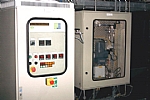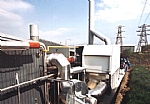- 60,000 contract/tender opportunities per year
- 4 Million UK Companies listed
- 12 million Director Names
- 100 million web pages indexed
AirProtekt Ltd
Overview
Products
Established in 1994,
AirProtekt provide Air Pollution Control Solutions worldwide, with an
in-depth, one-to-one service and individually tailored solutions. Our
decades of experience in the Air Pollution Control industry have seen
us develop a great amount of technical expertise, market knowledge
and practical skills, making us specialists in the provision of
custom systems.
We understand that
every application is different, so we provide custom solutions
through personal, one-to-one service. We also make sure that every
project is led by an AirProtekt executive, who assures that it will
be a successful solution. The key technologies used in our tailored
solutions are Honeycat Catalytic oxidation systems, Non-selective
catalytic reduction (NSCR), Industrial air pollution control
catalysts, Selective catalytic reduction (SCR) and Regenerative
thermal oxidation systems (RTO).
We have a global
network of professional agents and contacts who can provide sales and
technical support, and there is no project too large or too small for
our experienced team. As such, we have provided solutions to
organisations all over the world, including names such as 3M, Avecia,
BASF, BP/Amoco, British Aerospace, Caterpillar, Courtaulds, Dynea,
Johnson Matthey, Kemira, Kvaerner Process Technology, Nestle and
Ricoh. Our systems have been put to use everywhere from Europe to
North America, Asia, the Middle East and Oceania.
Honeycat Catalytic oxidation systems
Our Honeycat catalytic oxidation system consists of thin-walled honeycomb supports and finely dispersed Platinum Group Metals, which are impregnated into a high surface area washcoat. These Platinum Group Metal catalysts are derived from proven autocatalyst technology, which gives them various benefits over rival systems.The Honeycat Catalytic oxidation system provides great flexibility, with 30 minute or less warm-up times and the ability to use a range of different fuels. On top of this, it has fairly low fuel costs, and continuous operation often involves no fuel at all. This system provides abatement for a variety of chemicals, including light hydrocarbons, carbon monoxide, sulphated organics and chlorinated and non-chlorinated VOCs.

Non Selective Catalytic Reduction (NSCR)
In terms of Non Selective Catalytic Reduction (NSCR), we can provide either the complete package or the NSCR catalyst for NOx and N2O emission control in reduced oxygen air stream. This reaction involves nitrogen oxides and a fuel reacting together to form nitrogen and water. It can even reduce N2O to harmless nitrogen and water vapour, which normal SCR systems cannot do.The fuel may vary, depending on availability and price, but is generally natural gas, light naphtha or hydrogen. Benefits of this process are that it has a long catalyst life and a NOx removal rate of over 95%.

Industrial air pollution control catalysts
Our range of industrial catalysts includes the Standard VOC oxidation catalyst, Low molecular VOC oxidation catalysts, and Halogenated VOC oxidation catalysts.The standard catalyst is intended for treating most Volatile Organic Compounds (VOCs), and has the benefits of being poison resistant and capable of performing at low operating temperatures. It is particularly useful for applications in chemical manufacturing, printing, food processing and power generation.
The low molecular VOC oxidation catalysts are specifically intended to address methane, ethane, propane and other such low molecular VOCs. These catalysts have high durability, improved energy efficiency and very low emissions, and are suited for applications in chemical manufacturing, food processing and the power industry.
Halogenated VOC oxidation catalysts are for treating halogenated VOCs and are effective for use in PTA, chemical manufacturing and soil remediation applications.

Selective Catalytic Reduction (SCR)
Selective Catalytic Reduction (SCR) can be supplied as a complete package or for the control of NOx emissions. The NOx removal process uses urea as a reducing agent, as the oxygen present in exhaust gases does not generally affect it, and it is easily available.One benefit of this process is that the catalyst has a long life, which means that it can provide a high rate of NOx removal. In addition, the NOx is reduced to just nitrogen and water vapour, which avoids the problems that result from wastewater and solution. Usually, reactions such as this take a lot of time to complete, but with the AirProtekt catalyst, the reaction can be accelerated.

Regenerative thermal oxidation systems (RTO)
A wide variety of industrial processes that use organic compounds as solvents or reactive chemicals generate Volatile Organic Compounds (VOCs), which not only cause localised odour problems, but are also involved in environmentally damaging processes such as low-level ozone and smog generation.Our Regenerative Thermal Oxidations systems (RTO) are effective for the destruction of VOCs, and have high thermal efficiencies with minimal operating costs. The RTO system design is capable of treating high volumes of exhaust gases and its high temperature operation achieves VOC destruction efficiency of over 99%. It also has a purge system, which prevents the emission of untreated VOCs during the valve operating cycle.

Stationary engines catalysts
Continuous and standby use of internal combustion engines in industrial applications frequently results in the emission of nitrogen oxides (NOx), carbon monoxide (CO) and hydrocarbons (HC). These emissions can be harmful to the environment and people, in the form of irritation of the eyes, nose and throat, as well as drowsiness and headaches.AirProtekt provide all the proven oxidation, NOx reduction and 3-Way exhaust catalysts necessary to control emissions such as carbon monoxide, diesel, biodiesel and natural gas alkanes. Our air pollution control systems are capable of dealing with practically every emissions requirement for every engine. Benefits of our systems include high emission control efficiency, long life expectancy and low operating temperature performance.

Servicing and maintenance
Our experienced engineering team respond to servicing and maintenance demands with speed and efficiency, aiming to assure that our customers' systems are back on line within a matter of hours; even if that means working weekends or nights.Our services include breakdown maintenance and annual servicing of new or existing catalytic and thermal oxidation equipment, such as burners, valves, PLC and instrumentation; site surveys to find any process or abatement equipment shortfalls (with the relevant upgrade if requested); and inspections of internal combustion chambers including lining/wall repair. We can also provide the complete range of spare parts necessary for catalytic and thermal oxidation systems.

Optimisation of dryer and oven exhaust systems
Our engineering team can optimise dryer and oven exhausts, as part of our complete abatement project solution. This begins with site surveys, to measure plant and dryer exhaust flow rates and pressure drop, balance dryer zones and determine the drying efficiencies and correct LEL levels. This service includes various systems, such as bespoke exhaust systems for a variety of processes, with fail safe monitoring to abatement equipment and bypass vents; recirculation and cascade systems for the reduction of overall flow rates to abatement equipment; LEL solvent and flow monitoring systems; and process extraction systems that increase production throughout and decrease the exposure of unwanted local atmospheric solvents.
Engineering solutions
The highly experienced AirProtekt project engineering team can provide a variety of engineering solutions. These include site surveys that are done to determine process parameters, scope of supply, layouts, termination points and services to be provided. Our team also provide design and project management, such as the provision of drawing, AutoCAD files and manuals. Other solutions include mechanical and electrical installation (including transportation, off-loading and crane provision), commissioning of equipment and operator training.
Exhaust gas analysis
Another service we provide is VOC, CO and NOx exhaust gas analysis at customers' sites. This service consists of performance testing of new or existing equipment, annual emission tests with a report for the local authorities, site surveys to ascertain process solvent emissions and exhaust flow rates, recommendations regarding the most suitable technologies for the client, and other emission tests. As well as performing exhaust gas analysis, our engineering team can provide recommendations on the best available technologies for the specific site and application.
Honeycat Concentrator System
The Honeycat® Concentrator System is the abatement plant for low solvent concentration and low particulate manufacturing processes, with benefits such as low investment, low running costs and ease of integration into existing processes without optimisation. Its capacity to reach operating temperatures quickly means that it is also ideal for start and stop campaigns.This system pulls exhaust gases through a rotary honeycomb zeolite wheel, adsorbing the solvents from the process stream. The VOCs are transported into the regeneration zone, where they are removed via a small preheated steam, and the regenerated zeolite then rotates back into the process air to adsorb more VOCs from the process. The regeneration zone air is sent through a Honeycat Catalytic Oxidation system where the VOCs become carbon dioxide and water vapour.

Carbon Adsorption
When it comes to air pollution control, carbon adsorption is one of the most reliable technologies, with the highest removal efficiency around and the capacity to remove contaminants to levels of parts per trillion. Carbon has an incredibly vast internal surface area, with one kilogram having 1,000,000m² surface area, which means that it can function as an adsorbant when in its “virgin” state, or a chemiadsorbant when impregnated.Carbon is capable of adsorbing most contaminants and can deal with specialist compounds when impregnated with reagents. It can handle incredibly high loadings to removal over 99.9% until the carbon becomes loaded and contaminants can break through.

Details
Info
| Registration Number: | 02972026 |
| VAT Number: | n/a |
| Registered at Companies House: | 28 September, 1994 (29 years and 7 months ago) |
| No of Employees: | n/a |
| Annual Turnover: | n/a |
| Importers: | |
| Exporters: |
Opening Times
| Monday | 09:00 AM - 05:30 PM |
| Tuesday | 09:00 AM - 05:30 PM |
| Wednesday | 09:00 AM - 05:30 PM |
| Thursday | 09:00 AM - 05:30 PM |
| Friday | 09:00 AM - 05:30 PM |
| Saturday | Closed |
| Sunday | Closed |
Questions
Additional Information
Brand & Trade Names
- Johnson Matthey
- Lufftechnik Bayreuth GmbH
Gallery
Financial Information
To view more detailed financial information for this company click here.
- Electronic Product Designers
- Handyman Builder Sw Ltd
- ESSEX
- Jka Electrical Services Ltd
- BACKYARD BOTANICS Ltd
- Occupational Health Consultants
- Northwest German Car Sales Ltd
- Rutland Sports Ltd
- Robspeed Motorcycles Ltd
- Call Systems Technology Ltd
- Southern Valve & Fitting Co. Ltd
- Hartshorne Vets Ltd
- Methylene Chloride
- Hypoid Gears
- Ekc Ltd
- Northenden Golf Club Ltd
- Low Voltage Igniters
- The West Norwood Sports Club Ltd
- Parcelx Ltd








